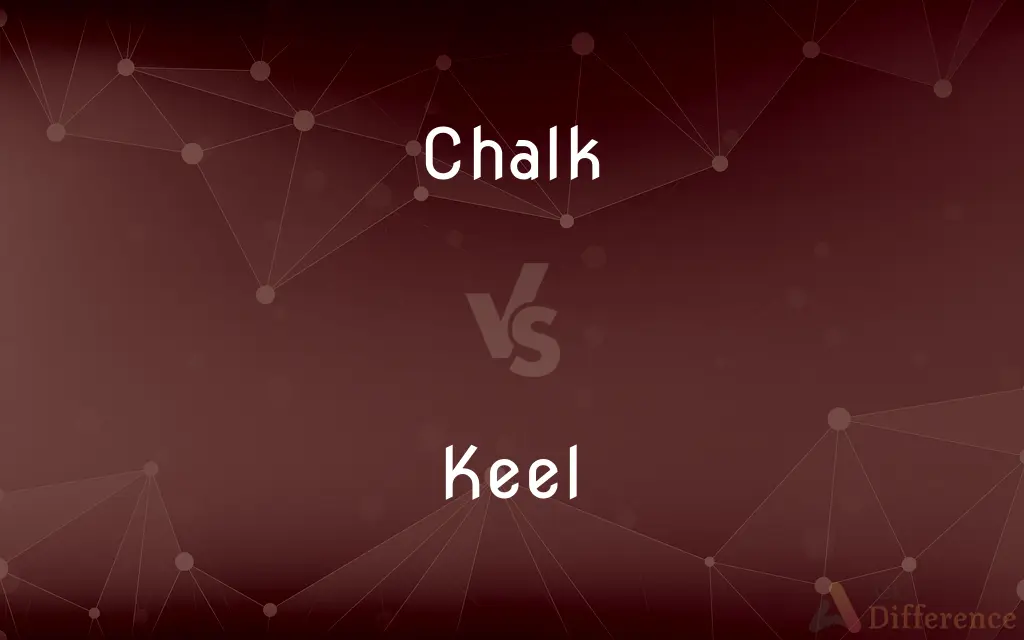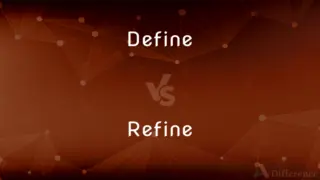Chalk vs. Keel — What's the Difference?
By Tayyaba Rehman & Urooj Arif — Updated on April 24, 2024
Chalk, a soft, white limestone, is primarily used for writing and drawing, whereas keel, a structural component of a ship, is essential for stability and steering.

Difference Between Chalk and Keel
Table of Contents
ADVERTISEMENT
Key Differences
Chalk is a sedimentary rock composed mainly of calcite, making it soft and ideal for marking on surfaces. Keel, on the other hand, is a central structure running along the bottom of a ship's hull, crucial for providing structural strength.
In educational and artistic contexts, chalk is valued for its ability to leave marks easily on blackboards and sidewalks. Keel, whereas, plays a vital role in nautical engineering, affecting a vessel's performance and balance.
Chalk can be easily erased and manipulated, which is why it's popular in classrooms and sports fields for temporary markings. In contrast, the keel is a permanent and integral part of a ship's design, significantly influencing its navigational properties.
The manufacturing processes for chalk involve mining and shaping soft limestone. Keel construction, on the other hand, requires robust materials like steel or wood and involves complex shipbuilding techniques.
Chalk production has minimal impact compared to keel construction, which is a major engineering undertaking with significant material and energy demands.
ADVERTISEMENT
Comparison Chart
Composition
Made of calcite, a form of calcium carbonate
Typically made of steel or wood
Primary Use
Writing and drawing
Provides stability and structural integrity to ships
Context of Use
Classrooms, artistic fields
Nautical engineering
Durability
Soft and easily erasable
Rugged and built to last
Environmental Impact
Low, involves simple extraction
High, requires extensive resources for construction
Compare with Definitions
Chalk
A soft white limestone used for writing on blackboards.
The teacher used red chalk to highlight important points.
Keel
Enhances the stability and steering of a vessel.
The new keel design improved the yacht's performance in rough waters.
Chalk
Used by tailors for marking fabric.
She used chalk to outline the pattern on the cloth.
Keel
Keel laying is a celebrated shipbuilding tradition.
The ceremony marked the laying of the keel for the new cruiser.
Chalk
Ground into powder for gymnastics and climbing to improve grip.
The climbers applied chalk to their hands before ascending.
Keel
The main beam of a ship or boat that runs along the bottom of the hull.
The damaged keel compromised the sailboat’s stability.
Chalk
Small sticks of colored chalk are used for drawing on sidewalks.
The children decorated the driveway with colorful chalk drawings.
Keel
Acts as the backbone for structural integrity in shipbuilding.
The workers installed the keel to begin the ship's construction.
Chalk
In sports, used to mark boundaries and game lines.
The groundskeeper chalked the baseball diamond.
Keel
In biology, refers to a specific structure resembling a ship's keel in some birds and plants.
The bird’s keel is well-developed for flight muscle attachment.
Chalk
Chalk is a soft, white, porous, sedimentary carbonate rock, a form of limestone composed of the mineral calcite and originally formed deep under the sea by the compression of microscopic plankton which had fallen to the sea floor. Chalk is common throughout Western Europe, where deposits underlie parts of France, and steep cliffs are often seen where they meet the sea in places such as the Dover cliffs on the Kent coast of the English Channel.
Keel
The keel is the bottom-most longitudinal structural element on a vessel. On some sailboats, it may have a hydrodynamic and counterbalancing purpose, as well.
Chalk
A white soft earthy limestone (calcium carbonate) formed from the skeletal remains of sea creatures.
Keel
The lengthwise timber or steel structure along the base of a ship, supporting the framework of the whole, in some vessels extended downwards as a ridge to increase stability.
Chalk
Short for French chalk
Keel
A ridge along the breastbone of many birds to which the flight muscles are attached; the carina.
Chalk
Write or draw with chalk
He chalked a message on the board
Keel
A prow-shaped pair of petals present in flowers of the pea family.
Chalk
Charge (drinks bought in a pub or bar) to a person's account
He chalked the bill on to the Professor's private account
Keel
A flat-bottomed boat of a kind formerly used on the Tyne and Wear Rivers for loading ships carrying coal.
Chalk
A soft compact calcite, CaCO3, with varying amounts of silica, quartz, feldspar, or other mineral impurities, generally gray-white or yellow-white and derived chiefly from fossil seashells.
Keel
(of a boat or ship) turn over on its side; capsize
It's going to take more wind to make this boat keel over
Chalk
A piece of chalk or chalklike substance in crayon form, used for marking on a blackboard or other surface.
Keel
The principal structural member of a boat or ship, running along the center of the hull from bow to stern, to which the ribs are attached.
Chalk
(Games) A small cube of chalk used in rubbing the tip of a billiard or pool cue to increase its friction with the cue ball.
Keel
A projecting ridge or fin on the bottom of the hull of a boat or ship that improves directional control and is often weighted for added stability.
Chalk
A mark made with chalk.
Keel
The principal structural member of an aircraft, resembling a ship's keel in shape and function.
Chalk
Chiefly British A score or tally.
Keel
A structure, such as the breastbone of a bird, that resembles a ship's keel in function or shape.
Chalk
To mark, draw, or write with chalk
Chalked my name on the blackboard.
Keel
A pair of united petals in certain flowers, as those of many members of the pea family.
Chalk
To rub or cover with chalk, as the tip of a billiard cue.
Keel
A sail-powered barge, especially one historically used on the rivers of northern England.
Chalk
To make pale; whiten.
Keel
The load capacity of this barge.
Chalk
To treat (soil, for example) with chalk.
Keel
A British unit of weight formerly used for coal, equal to about 21.2 long tons.
Chalk
(uncountable) A soft, white, powdery limestone (calcium carbonate, CaCO3).
Chalk cliffs are not recommended for climbing
Keel
To capsize or cause to capsize.
Chalk
(countable) A piece of chalk, or nowadays processed compressed gypsum (calcium sulfate, CaSO4), that is used for drawing and for writing on a blackboard (chalkboard).
The chalk used to write on the blackboard makes a squeaky sound
Keel
To make cool.
Chalk
Tailor's chalk.
Keel
(nautical) A large beam along the underside of a ship’s hull from bow to stern.
Chalk
A white powdery substance used to prevent hands slipping from holds when climbing, or losing grip in weight-lifting or gymnastics, sometimes but not always limestone-chalk, often magnesium carbonate (MgCO3).
When working out your next move, it's a good idea to get some more chalk from the bag
Keel
(nautical) A rigid, flat piece of material anchored to the lowest part of the hull of a ship to give it greater control and stability.
Chalk
A platoon-sized group of airborne soldiers.
Keel
(aeronautics) In a dirigible, a construction similar in form and use to a ship's keel; in an aeroplane, a fin or fixed surface employed to increase stability and to hold the machine to its course.
Chalk
The favorite in a sporting event.
Keel
(by extension) The rigid bottom part of something else, especially an iceberg.
Chalk
The prediction that there will be no upsets, and the favored competitor will win.
Keel
(nautical) A type of flat-bottomed boat.
Chalk
To apply chalk to anything, such as the tip of a billiard cue.
Chalk your hands before climbing
Keel
(zoology) The periphery of a whorl extended to form a more or less flattened plate; a prominent spiral ridge.
Chalk
To record something, as on a blackboard, using chalk.
Keel
(botany) The two lowest petals of the corolla of a papilionaceous flower, united and enclosing the stamens and pistil; a carina.
Chalk
To use powdered chalk to mark the lines on a playing field.
Keel
(brewing) A broad, flat vessel used for cooling liquids; a brewer's cooling vat; a keelfat.
Chalk
(figuratively) To record a score or event, as if on a chalkboard.
Keel
(Scotland) Red chalk; ruddle.
Chalk
To manure (land) with chalk.
Keel
To collapse, to fall
He keeled over after having a stroke.
Chalk
To make white, as if with chalk; to make pale; to bleach.
Keel
To traverse with a keel; to navigate.
Chalk
A soft, earthy substance, of a white, grayish, or yellowish white color, consisting of calcium carbonate, and having the same composition as common limestone.
Keel
To turn up the keel; to show the bottom.
Chalk
Finely prepared chalk, used as a drawing implement; also, by extension, a compound, as of clay and black lead, or the like, used in the same manner. See Crayon.
Keel
To cool; make cool; to cool by stirring or skimming in order to keep from boiling over.
While greasy Joan doth keel the pot (Shakespeare)
Chalk
To rub or mark with chalk.
Keel
To moderate the ardour or intensity of; assuage; to appease, pacify, or lessen.
Chalk
To manure with chalk, as land.
Keel
To become cool; cool down.
Chalk
To make white, as with chalk; to make pale; to bleach.
Let a bleak paleness chalk the door.
Keel
To mark with ruddle.
Chalk
A soft whitish calcite
Keel
Pronunciation spelling of kill
Chalk
A pure flat white with little reflectance
Keel
To cool; to skim or stir.
While greasy Joan doth keel the pot.
Chalk
Amphetamine used in the form of a crystalline hydrochloride; used as a stimulant to the nervous system and as an appetite suppressant
Keel
To traverse with a keel; to navigate.
Chalk
A piece of chalk (or similar substance) used for writing on blackboards or other surfaces
Keel
To turn up the keel; to show the bottom.
Chalk
Write, draw, or trace with chalk
Keel
A brewer's cooling vat; a keelfat.
Keel
A longitudinal timber, or series of timbers scarfed together, extending from stem to stern along the bottom of a vessel. It is the principal timber of the vessel, and, by means of the ribs attached on each side, supports the vessel's frame. In an iron vessel, a combination of plates supplies the place of the keel of a wooden ship. See Illust. of Keelson.
Keel
Fig.: The whole ship.
Keel
A barge or lighter, used on the Tyne for carrying coal from Newcastle; also, a barge load of coal, twenty-one tons, four cwt.
Keel
The two lowest petals of the corolla of a papilionaceous flower, united and inclosing the stamens and pistil; a carina. See Carina.
Keel
A projecting ridge along the middle of a flat or curved surface.
Keel
In a dirigible, a construction similar in form and use to a ship's keel; in an aëroplane, a fin or fixed surface employed to increase stability and to hold the machine to its course.
Keel
The median ridge on the breastbone of birds that fly
Keel
One of the main longitudinal beams (or plates) of the hull of a vessel; can extend vertically into the water to provide lateral stability
Keel
Walk as if unable to control one's movements;
The drunken man staggered into the room
Common Curiosities
Can chalk be used on any surface?
Chalk is best used on rough surfaces like blackboards and sidewalks where it can leave visible marks.
How is chalk manufactured?
Chalk is manufactured by mining natural chalk, crushing it, and then forming it into sticks.
What are the environmental impacts of chalk?
Chalk has a low environmental impact, mainly involving the extraction of limestone.
How does the keel affect a ship's performance?
The keel plays a crucial role in the ship’s balance and navigational ability, especially in steering and stability.
What materials are used to make a keel?
Keels are commonly made from steel or wood, depending on the type of ship.
What is a keel laying ceremony?
A keel laying ceremony is a traditional event marking the beginning of a ship's construction.
How is a keel constructed?
Keels are constructed using durable materials like steel or wood, and are integral to the ship's design.
What is chalk made of?
Chalk is primarily made of calcite, a crystalline form of calcium carbonate.
How is chalk used in education?
Chalk is commonly used by teachers for writing on blackboards to display information visually.
What is the purpose of a keel on a ship?
The keel provides stability and structural integrity to ships, helping them navigate better.
Share Your Discovery

Previous Comparison
Define vs. Refine
Next Comparison
Peacefully vs. PeacefulAuthor Spotlight
Written by
Tayyaba RehmanTayyaba Rehman is a distinguished writer, currently serving as a primary contributor to askdifference.com. As a researcher in semantics and etymology, Tayyaba's passion for the complexity of languages and their distinctions has found a perfect home on the platform. Tayyaba delves into the intricacies of language, distinguishing between commonly confused words and phrases, thereby providing clarity for readers worldwide.
Co-written by
Urooj ArifUrooj is a skilled content writer at Ask Difference, known for her exceptional ability to simplify complex topics into engaging and informative content. With a passion for research and a flair for clear, concise writing, she consistently delivers articles that resonate with our diverse audience.














































